

 |
 |
I fancied a photo shoot, there was nothing exciting expected in the night sky this week however the charts were showing that it was going to be a clear night which has been rare this season so I decided a shoot would be good to shake off the cobwebs. I had agreed to meet up with photographer and drone pilot Nigel McFarland from AerialVision NI, the plan was to arrive at the coast a couple of hours before sunset, spend the daylight training with the drones then once darkness fell we would do a star trail shoot, we had a few locations in mind however the statue on Binevenagh was our main target as neither of us had captured this famous local landmark at night before. Forecast models indicated we had quite a few hours of clear skies expected before high level cloud would arrive later in the night ahead of the next frontal system.
I arrived at the north coast at 18.00, the drive from Maghera had been under clear blue skies with passing cumulus clouds and completely dry however when I arrived at the coast I encountered very slow moving heavy showers so I parked up and waited for half an hour under the deluge then the sun broke out spawning a primary and secondary rainbow over Binevenagh mountain which made for quite a sight, then blue skies returned and things were looking very good indeed. There was also a convective outlook issued however with the exception of a few heavy high based showers I wasn't expecting anything to produce, I didn't even see any mammatus or proper towers behind the showers so I expected the convective component of this day to be a damp squib. Having said that GFS did show in the order of 500-600 CAPE over the ocean to the N and NW this evening and tonight however I never expected it to produce based on the caliber of what I was seeing inland.
During the last hour of daylight we ended up burning through two or three batteries with the Phantoms and filming the coastline which was a great way to spend the day. After sunset on a dead calm sea there was a beautiful blue glow to the sky during dusk and as the first of the stars appeared overhead we could see a line of three convective updraughts far away to the NE, they looked solid and were bathed in an atmospheric white-blue cast as dusk transitioned into twilight, the cells where many miles away yet painted a beautiful picture in the skyline, I half joked to Nigel saying it's a pity there was no lightning from those. We packed up the drones after a successful evening of flying and enjoyed a flask of tea and snacks then waited for full darkness to settle.
 |
We drove to the top of Binevenagh along the back mountain road and arrived at the beautiful Gortmore viewing point then made our way with the gear to the Manannan Mac Lir statue. It was shocking how windy it was, the forecast had said 10mph winds but it was much stronger at this elevation and for a while I doubted we could get a workable star trail for if the wind vibrated the tripod at all it would destroy an entire star trail shoot. Furthermore my tripod feet were slipping in the wet mud so it took some time to get a workable composition and a more solid section of ground. This area is spectacular however there's serious light pollution from the prison and from the lights in city, however to compensate for that the view was stunning across Lough Foyle, Magilligan Point and over Donegal to the wild Atlantic Ocean. I have wanted to shoot a star trail at this statue for a long time and now it was finally happening, I was shooting 25 sec exposures at 10mm wide angle F/2.8 at ISO1600, cable release in, timer on and the exposures began, Nigel was also shooting a star trail from the right hand side of the statue, we made sure our angles worked so that none of our cameras would appear in each others final image, we left the cameras on the mountain exposed to the wind and made our way back to the vans for shelter.
As the cameras did their thing we chatted away in the van about all things photography related while enjoying a warm brew while admiring the stars and the distant lights from passing ships at sea. Less than one our later, and just before midnight, I glanced out the driver's side window and saw a bright blue flash of lightning which immediately got my attention, it was very bright and seemed to originate from the ocean on the other side of Donegal at quite some distance, however its magnitude demanded attention. We watched a while and saw nothing else, I was surprised to have seen that if I'm to be honest and just assumed it was one flash from a pop corn cell which was probably decaying. We continued chatting then suddenly another bright blue flash, this one renewed our interest however it wasn't enough to change our course of action and stop our star trail so yet again we went back to chatting. Soon after there was another and this time it was a game changer, the flash had appeared from the now visible skyline to the E of Donegal, and this time instead of a distant flash I saw a cell lit up from inside by lightning, I could see structure. This time we took the hint from Mother Nature and went outside and made our way back to the statue to investigate. I stopped the star trail and previewed my images and bingo, I had captured two incidents of lightning on my 10mm frames, the above shows the brightest of these, despite the massive distance you can clearly see a big thunderstorm way out over the ocean.
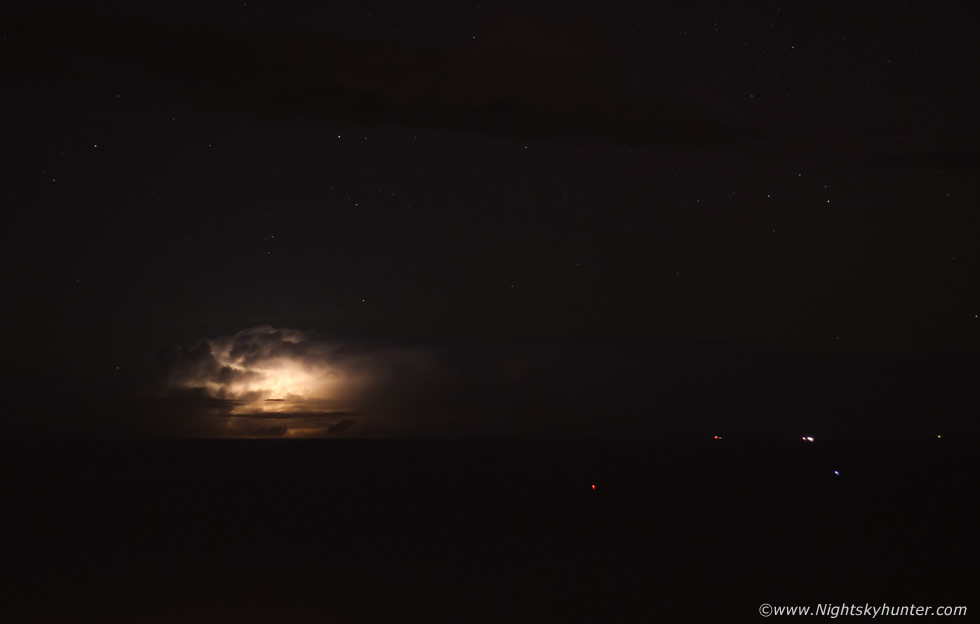 |
This storm became our new target, I needed to get in closer, however my Canon 100-400mm USM lens was too slow with widest aperture at F/5.6 at 100mm and closing rapidly when zoomed in further, it's a fantastic lens however it is quite useless for night work unless you have a tracking mount, the cell would trail too much in the exposure so I couldn't use this. Also my Canon 24-70mm F/2.8 lens was playing up, there was a regular fault with the lens contact elements so the camera simply wouldn't read the lens at all and wouldn't work, that left my trusty 50mm F/1.8, a lens which my Wife Roisin bought me for Christmas years ago and which has served me well on many occasions. I began doing short exposures manually with the cable release in the off chance we would be lucky enough to get another flash. We were more than lucky, this cell flashed with lightning periodically for quite some time and as it flashed it lit up the inside of the storm revealing structure, in all these images the storm was moving slowly from L to R.
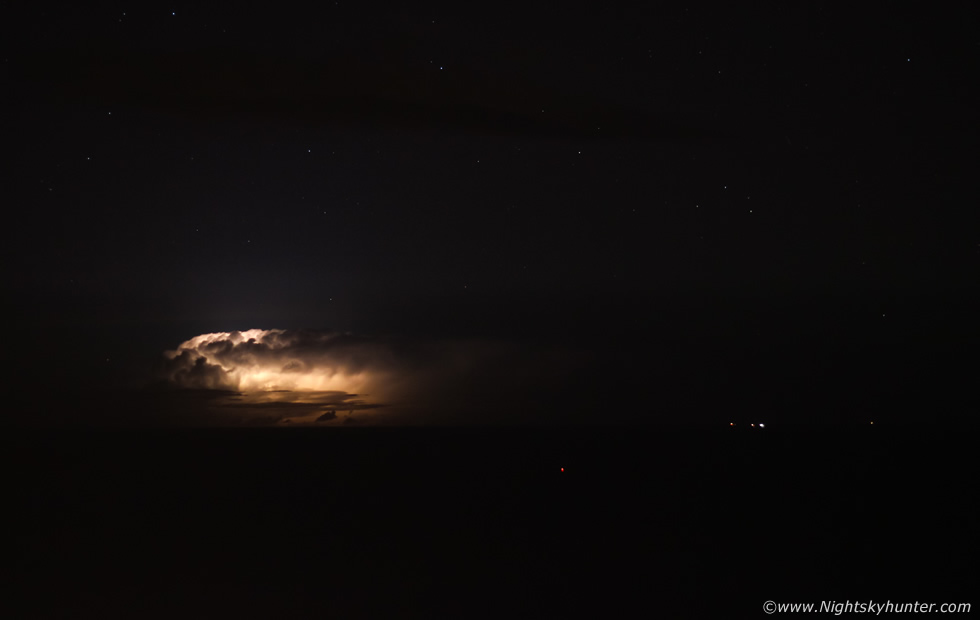 |
It was quite apparent that this was a sheared multicell located some distance away and off great height in the troposphere, each bright flash revealed a cell with solid updraughts and anvil/precip sheared downwind for miles across the sea then in a blink of an eye the scene was plunged back into darkness.
 |
I kept taking short exposures as the wind whipped our backs and this delightful storm continued to put on a show for us. Getting a night storm with lightning and structure is difficult enough in this country, but to get a storm surrounded by clear sky and excellent visibility is even more rare and getting stars around such a scene is at the top of the photogenic list, this one was doing us proud.
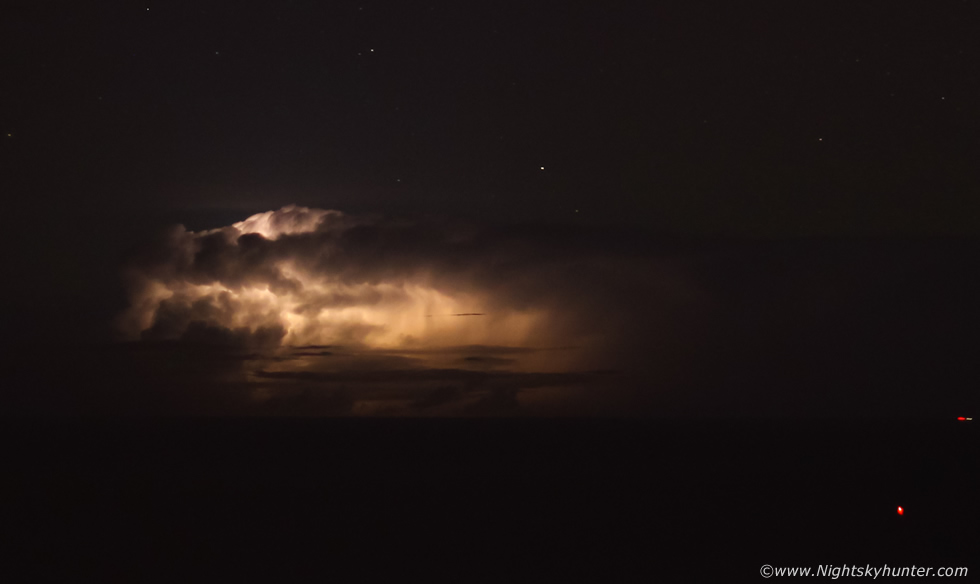 |
I bet the sailors on board those ships where getting some view, you can see a clear overshooting top punching above the anvil level with solid cloud structure throughout, these are good visual signs of a very strong updraught within this storm. You can also see subtle mammatus hanging from under the side flank of the anvil. The remainder of the anvil and precip extends far into the right and beyond this frame and in complete darkness as the electrically active element of this storm was focused on the rear updraught, likely a tail end charlie situation. On occasion we had double flashes, we could tell one was in-cloud and the other a c-g.
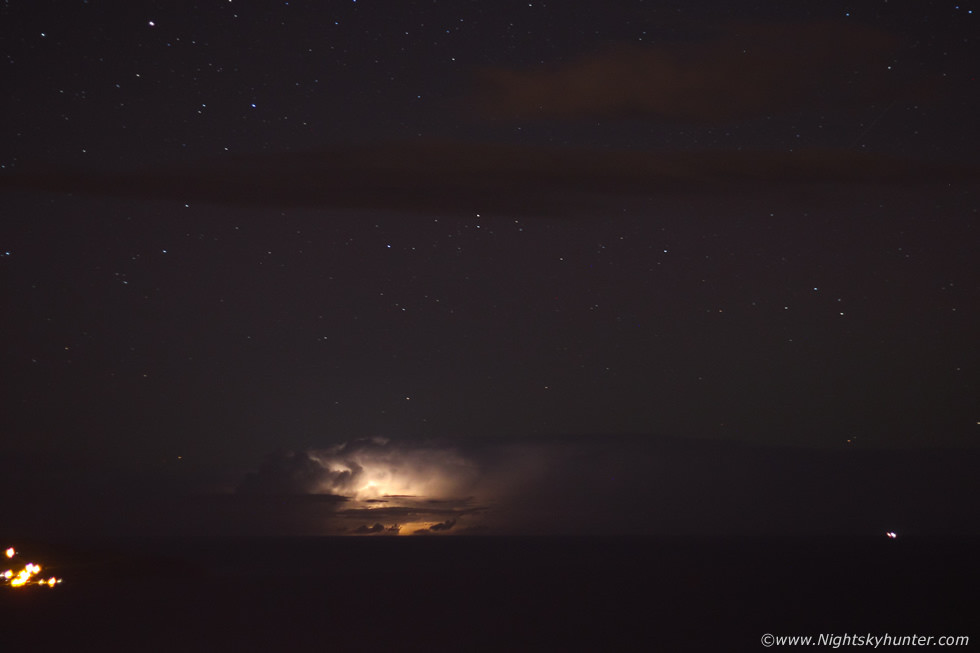 |
A longer exposure and another double lightning flash revealed the anvil, a growing new updraught at the rear, and a short flanking line of new updraughts. The bright lights on the left are from the tip of Donegal, this back building storm was moving NE and heading for the W coast of Scotland. During Summer inland areas become the focus point for thunderstorms due to strong heating of the land mass, solar heating is one form of lift needed for thunderstorm development. However during the Autumn and Winter the land rapidly cools down but in turn the ocean gets warmer, storm chasers refer to these ocean temperatures as SSTs or Sea Surface Temperatures.
Atlantic low pressure systems often drag down cold air within their post-frontal sectors, often this air originates from far N or NW Atlantic as a far as Canada or the Arctic, this modified cold air overspreading a warm moist sea generates instability and a perfect set-up for cold air mass convection. These set-ups are prolific over the Autumn and Winter period affecting oceans and inland coastal areas in the form of hail showers, thunderstorms and even thundersnow storms, they can be of the pulse storm variety however more often than not the nearby jet stream can aid with vertical wind shear forming organized ocean storms, on occasion even low topped supercell type storms have happened, this is why I love this time of year, the storms continue all year round, however its only their location and initiation mode which changes.
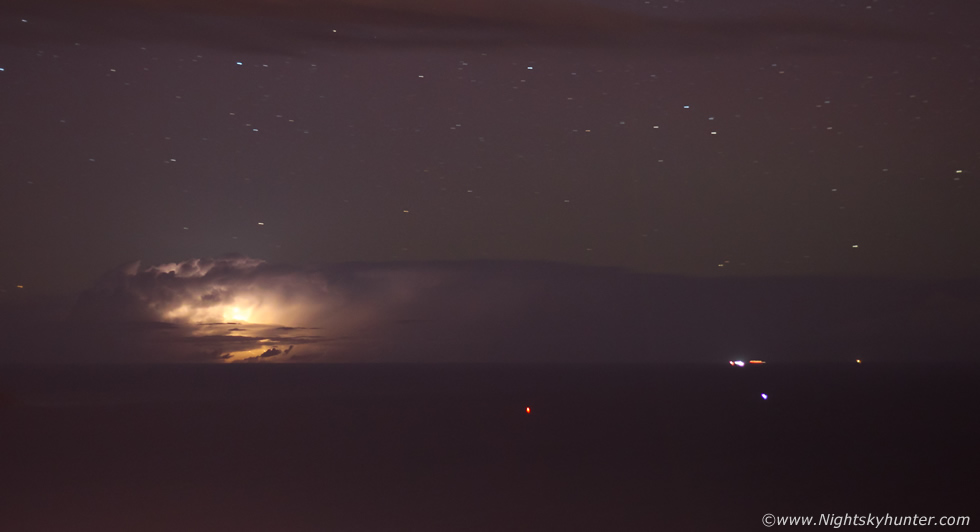 |
A longer exposure brightens the scene however it also trails the stars with a higher risk of burning out the lightning, it also enhanced the light glare from Magilligan prison below, the air above the lights was rich in moisture after a passing rain shower, you can really appreciate the length of the storm in this one. The wind was very uncomfortable hitting our backs relentlessly and chilling our core temperature so we set up the cameras behind the statue and let Manannan Mac Lir serve as wind break which offered us shelter. While we were shooting patrol images I was picking up a faint aurora on camera, on each short exposure I could see green sky with red above over the top of the storm, this was also unexpected as no activity was forecast tonight however at the same time it was not surprising as being on the north coast in a dark sky with a flat ocean horizon is the perfect ingredient for detecting even faint aurora. Remember that even though the oval is not over you doesn't mean an aurora cant be detected, the aurora is extremely high in altitude so the tops of even distant displays can still be captured from ideal viewing locations, this was one such example, hardly jaw dropping, however interesting in itself and even more special with a flashing thunderstorm.
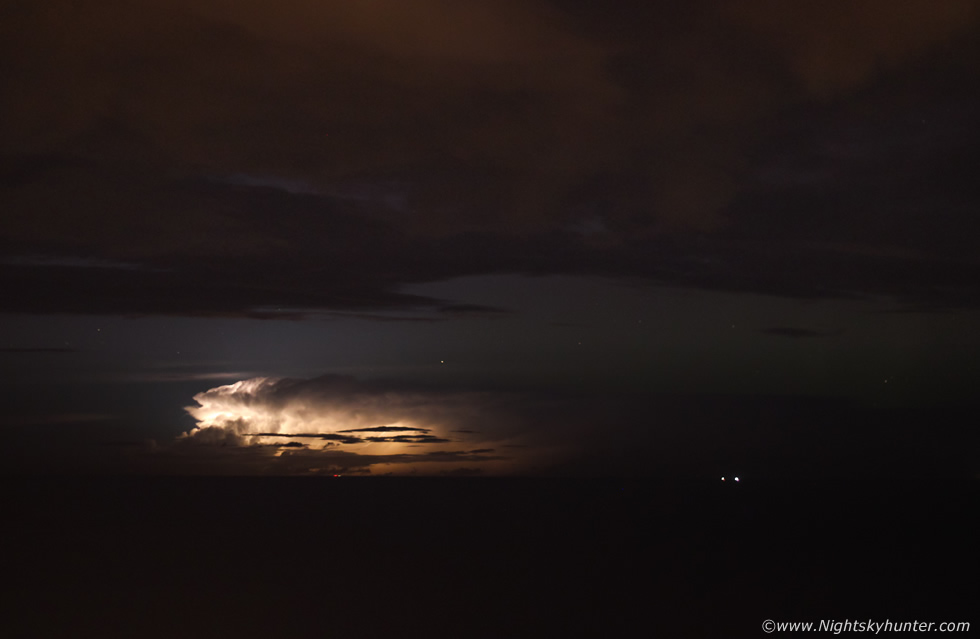 |
Another double whammy of lightning during the climax of the storm, look carefully from a dark room and you can see a faint green aurora with pillars visible to the right, I have to say it was quite a satisfying feeling to get aurora and lightning in the same frame, it felt all the more rewarding on a night when neither were expected.
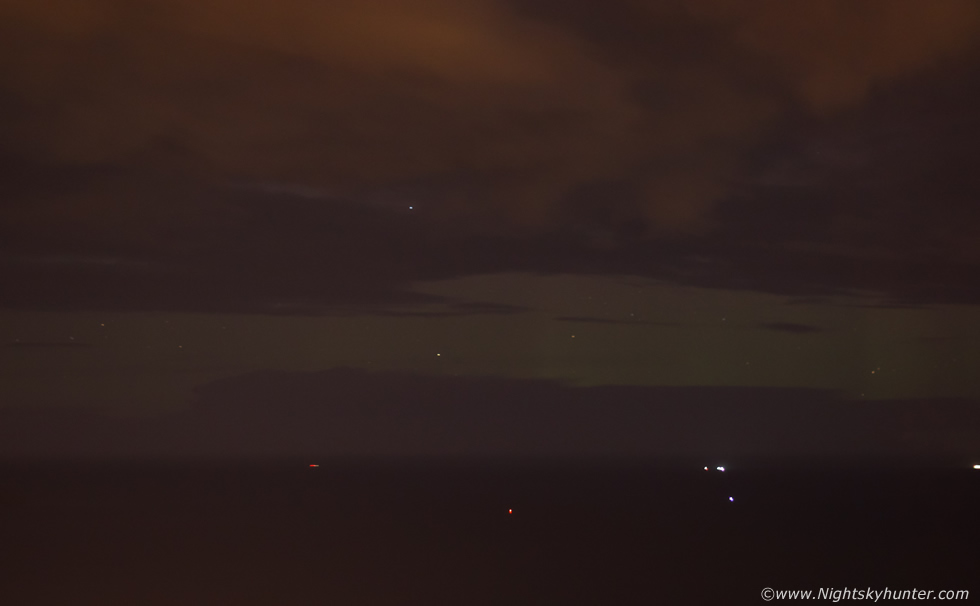 |
Patrol image of same storm without lightning but with at least three aurora beams above the multicell. The sea was a busy place this night, some of the lights are from buoys marking the anchorage area outside Lough Foyle, the other lights belong to fishing boats and distant ships, the red and green lights together on the left are from the Strathfoyle tug in the process of towing a stricken cargo ship from Scotland destined for Lisahally.
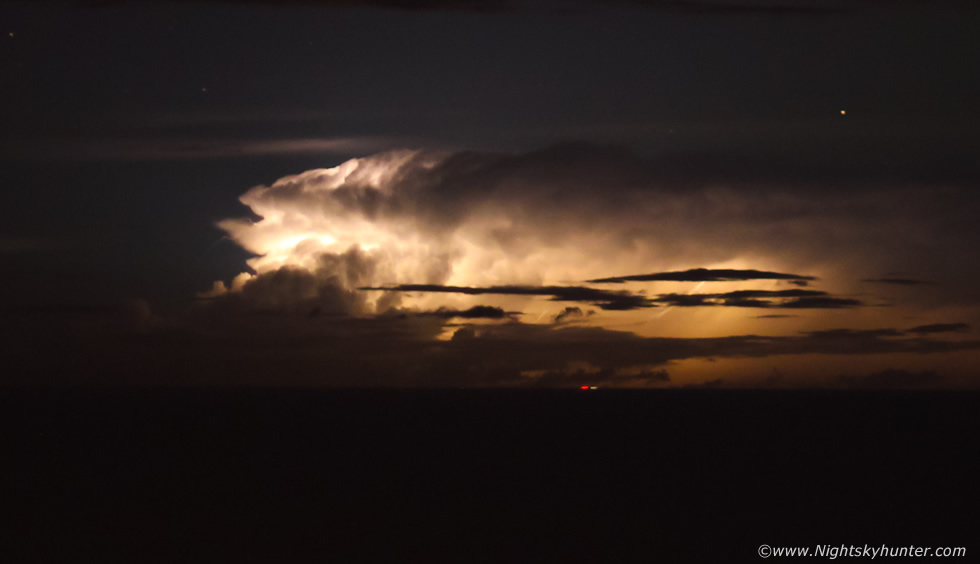 |
Deep crop from the last capture showing the main updraught and flanking area, you can see a long staggered in-cloud bolt at image centre and at the back end there's another bolt poking out from the anvil cloud, that's a cloud to air bolt, both happened at the same time, flash flash, then the storm turned back to darkness and remained quiet for the rest of the shoot. Now had this storm been 30-40 miles closer and had that aurora been stronger we would have come home with truly epic images this night, however I was far from disappointed, in fact, I was delighted to witness this unexpected treat from this location and to see an illuminated storm with structure surrounded by stars and the icing on the cake was that subtle aurora, I went out for a star trail but came back with an elemental bounty, nature was good to us this night. I later checked radar and worked out that these storms where at least 70 miles away over the sea, in that context I think we done very well indeed.
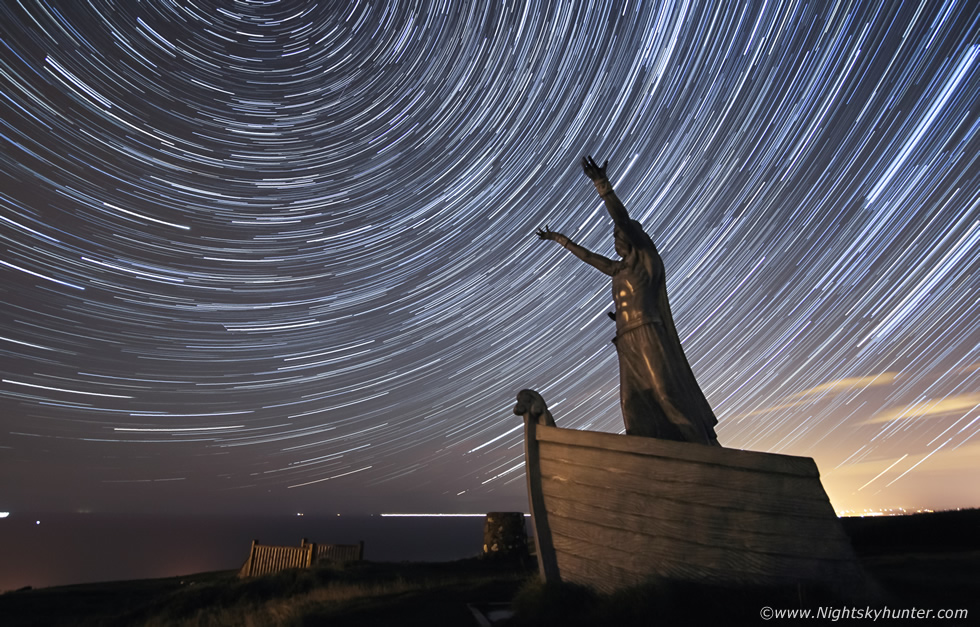 |
Nigel and I did a second star trail at the statue, my first was ruined by passing car lights however this one turned out nice, 45 min's worth of exposures stacked using tungsten white balance, I got my star trail after all. High level cloud arrived at 01.30 so we ended the shoot and called a night, I made two short time lapse sequences from these stills which I will feature on my end of year video presentation, thanks very much for reading.
Martin McKenna